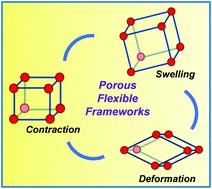当前位置:
X-MOL 学术
›
Mater. Horiz.
›
论文详情
Our official English website, www.x-mol.net, welcomes your feedback! (Note: you will need to create a separate account there.)
Porous flexible frameworks: origins of flexibility and applications
Materials Horizons ( IF 13.3 ) Pub Date : 2020-11-17 , DOI: 10.1039/d0mh01710h Saona Seth 1 , Samik Jhulki
Materials Horizons ( IF 13.3 ) Pub Date : 2020-11-17 , DOI: 10.1039/d0mh01710h Saona Seth 1 , Samik Jhulki
Affiliation

|
Porous crystalline frameworks including zeolites, metal–organic frameworks (MOFs), covalent organic frameworks (COFs) and hydrogen-bonded organic frameworks (HOFs) have attracted great research interest in recent years. In addition to their assembly in the solid-state being fundamentally interesting and aesthetically pleasing, their potential applications have now pervaded in different areas of chemistry, biology and materials science. When framework materials are endowed with ‘flexibility’, they exhibit some properties (e.g., stimuli-induced pore breathing and reversible phase transformations) that are distinct from their rigid counterparts. Benefiting from flexibility and porosity, these framework materials have shown promise in applications that include separation of toxic chemicals, isotopes and hydrocarbons, sensing, and targeted delivery of chemicals. While flexibility in MOFs has been widely appreciated, recent developments of COFs and HOFs have established that flexibility is not just limited to MOFs. In fact, zeolites—that are considered rigid when compared with MOFs—are also known to exhibit dynamic modes. Despite flexibility may be conceived as being detrimental to the formation and stability of periodic structures, the landscape of flexible framework structures continues to expand with discovery of new materials with promising applications. In this review, we make an account of different flexible framework materials based on their framework types with a more focus on recent examples and delve into the origin of flexibility in each case. This systematic analysis of different flexibility types based on their origins enables understanding of structure–property relationships, which should help guide future development of flexible framework materials based on appropriate monomer design and tailoring their properties by bottom-up approach. In essence, this review provides a summary of different flexibility types extant to framework materials and critical analysis of importance of flexibility in emerging applications.
中文翻译:

多孔灵活框架:灵活性和应用的起源
近年来,包括沸石、金属有机骨架(MOFs)、共价有机骨架(COFs)和氢键有机骨架(HOFs)在内的多孔晶体骨架引起了极大的研究兴趣。除了它们在固态下的组装从根本上来说是有趣和美观的,它们的潜在应用现在已经遍及化学、生物学和材料科学的不同领域。当框架材料被赋予“柔韧性”时,它们会表现出一些特性(例如,刺激诱导的孔隙呼吸和可逆相变),这与它们的刚性对应物不同。得益于柔韧性和多孔性,这些框架材料在包括有毒化学品、同位素和碳氢化合物的分离、传感和化学品定向输送在内的应用中显示出前景。虽然 MOF 的灵活性已得到广泛认可,但最近 COF 和 HOF 的发展表明,灵活性不仅限于 MOF。事实上,沸石——与 MOF 相比被认为是刚性的——也被认为表现出动态模式。尽管柔性可能被认为不利于周期性结构的形成和稳定性,但随着具有前景应用的新材料的发现,柔性框架结构的前景继续扩大。在本次审查中,我们根据其框架类型对不同的灵活框架材料进行了说明,更加关注最近的示例,并深入研究每种情况下灵活性的起源。这种基于起源对不同柔性类型的系统分析有助于理解结构-性能关系,这将有助于指导基于适当单体设计的柔性框架材料的未来发展,并通过自下而上的方法定制其性能。本质上,这篇综述总结了框架材料中存在的不同灵活性类型,并对新兴应用中灵活性的重要性进行了批判性分析。这种基于起源对不同柔性类型的系统分析有助于理解结构-性能关系,这将有助于指导基于适当单体设计的柔性框架材料的未来发展,并通过自下而上的方法定制其性能。本质上,这篇综述总结了框架材料中存在的不同灵活性类型,并对新兴应用中灵活性的重要性进行了批判性分析。这种基于起源对不同柔性类型的系统分析有助于理解结构-性能关系,这将有助于指导基于适当单体设计的柔性框架材料的未来发展,并通过自下而上的方法定制其性能。本质上,这篇综述总结了框架材料中存在的不同灵活性类型,并对新兴应用中灵活性的重要性进行了批判性分析。
更新日期:2020-11-27
中文翻译:

多孔灵活框架:灵活性和应用的起源
近年来,包括沸石、金属有机骨架(MOFs)、共价有机骨架(COFs)和氢键有机骨架(HOFs)在内的多孔晶体骨架引起了极大的研究兴趣。除了它们在固态下的组装从根本上来说是有趣和美观的,它们的潜在应用现在已经遍及化学、生物学和材料科学的不同领域。当框架材料被赋予“柔韧性”时,它们会表现出一些特性(例如,刺激诱导的孔隙呼吸和可逆相变),这与它们的刚性对应物不同。得益于柔韧性和多孔性,这些框架材料在包括有毒化学品、同位素和碳氢化合物的分离、传感和化学品定向输送在内的应用中显示出前景。虽然 MOF 的灵活性已得到广泛认可,但最近 COF 和 HOF 的发展表明,灵活性不仅限于 MOF。事实上,沸石——与 MOF 相比被认为是刚性的——也被认为表现出动态模式。尽管柔性可能被认为不利于周期性结构的形成和稳定性,但随着具有前景应用的新材料的发现,柔性框架结构的前景继续扩大。在本次审查中,我们根据其框架类型对不同的灵活框架材料进行了说明,更加关注最近的示例,并深入研究每种情况下灵活性的起源。这种基于起源对不同柔性类型的系统分析有助于理解结构-性能关系,这将有助于指导基于适当单体设计的柔性框架材料的未来发展,并通过自下而上的方法定制其性能。本质上,这篇综述总结了框架材料中存在的不同灵活性类型,并对新兴应用中灵活性的重要性进行了批判性分析。这种基于起源对不同柔性类型的系统分析有助于理解结构-性能关系,这将有助于指导基于适当单体设计的柔性框架材料的未来发展,并通过自下而上的方法定制其性能。本质上,这篇综述总结了框架材料中存在的不同灵活性类型,并对新兴应用中灵活性的重要性进行了批判性分析。这种基于起源对不同柔性类型的系统分析有助于理解结构-性能关系,这将有助于指导基于适当单体设计的柔性框架材料的未来发展,并通过自下而上的方法定制其性能。本质上,这篇综述总结了框架材料中存在的不同灵活性类型,并对新兴应用中灵活性的重要性进行了批判性分析。



























 京公网安备 11010802027423号
京公网安备 11010802027423号